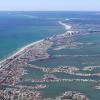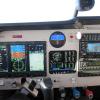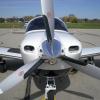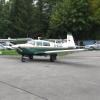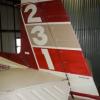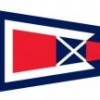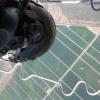Leaderboard
Popular Content
Showing content with the highest reputation on 04/06/2015 in all areas
-
My daughter didn't want to drive back to Atlanta and then drive down to the beach, so I flew her to Hank's place to let her spend the night with him and his wife. Hank lives right next to I85 and was kind enough to provide her with a room until her friends pass by tomorrow. Gave me an excuse to fly and saved my daughter ~5 hours of driving.2 points
-
Sorry, I didn't mean to infer this at all. My only point is that if there are two M20C's for sale. One is $50K and the other is $25K. It would likely take 100K to get it to the same condition as the $50K bird. Therefore, the best money is to buy the $50K example. You'll probably still have some restoration to do, but you're starting much higher up the ladder. I started looking at $20 to $30K Mooney's and after learning the market I bought a $50K M20C. And I've continued to improve it from there. I've added a nice engine monitor, AOA, and addressed some very minor squawks, but squawks none the less. Someday when I sell it to buy a Rocket :-), it will still just be a $50K airplane, but will be better than when I started.2 points
-
+1 If someone wishes to run a 1998 M20J into the ground and turn it into a piece of crap, so be it. But at some point, I believe we do become caretakers of our aircraft, and we owe it to our fellow pilots and Mooney lovers, as well as the next generation, to pass along airplanes that are better than when we got them. Mine is 51 now and better than when I got her.2 points
-
I feel like each owner should keep the plain dry, airworthy, and sprinkle in some value add to it over time as budget allows. That is what I plan to do and when I sell it the next guy can pick up where I left off with an airworthy airplane that he can fly safely and make some upgrades and long term repairs. For example, the previous owner spent 4k on the annual when I bought it. I resealed tanks, replaced nav com 2, and put in a new windshield and tires. I am now fixing the loose transponder and non working engine instruments. Next up is some basic interior work, not super luxury but more like refurbishing anything broken or cracked or yellowing. People that don't so stuff like this ame just fly it into the ground before selling it are getting some bad karma or something imho.2 points
-
Let's just start with the basics of "why a C model" for the initiated: There are more Cs than any other model. They are stone simple (even my electric model). Acquisition cost is lower. Easier to learn (fewer controls). No hot start issues. Less expensive insurance. Faster, cheaper annuals. Cs are great planes! We love ours.2 points
-
Go to www.mooneycaravan.com for details on this. This is your Northeast training opportunity. Get in contact with Sled and he will get you set up for this clinic.2 points
-
My Powerflow experience was on a previously owned 172 with an 0-320 D2G 160 hp RAM conversion. In order to try and justify my purchase, I spent quite a bit of time and effort testing the aircraft before and after the conversion. Starting at a home field elevation of 1130' I performed a time to climb to 9500' doing my best to control the airspeed the exact same on all tests. I completed the time to climb on runway heading then landed and repeated it off the runway 180 degrees the opposite direction to try and compensate for winds aloft. That afternoon we installed the PF system and I repeated the same flight tests the next morning with temperature and winds aloft almost exactly the same as the initial flights. End results were what I expected to see. Increased climb rate of 130' fpm. The aircraft did not have a CHT or EGT gauge so, I was unable to monitor for those parameters. The oil temp settled in about one needle width lower on the open faced gauge so I know the engine was in fact running a little bit cooler. How much, I don't know. Prior to this test, I had been flying at 2400 rpm in cruise with a fixed pitch prop and burned 9.3 gph over an average of almost 200 hours. After the PF, the fuel burn dropped to 8.8 gph. At the same setting. Best I could tell, it gained between 2-3 kts in cruise. The older airspeed indicators make it a bit more difficult to quantify that number but, I do believe it increased a small amount. The most important number of all for me at the time was take-off roll. I was operating off a 2000' grass strip. The PF decreased my take-off distance almost exactly 150'. That may not sound like much but when you are coming off grass and are heavy loaded, that extra confidence was absolutely worth the cost of the system in my opinion. You guys can argue the square root of this or that, or whatever you want. The fact is, the system works well in a Cessna 172. If and when I need a system for the Mooney, I would not hesitate to order another one. Tim2 points
-
I have changed the defaults to 25 positive events and 5 negative ones per day (was 10/1 before).2 points
-
Send the $15,500 to me, and forget about this aircraft. You will be money ahead, and a lot happier. I have no hidden fees for this service.2 points
-
For any of you thinking of doing one of the formation clinics I put together this video it has some great narrative in it. I was able to get out to the clinic a day early which I highly recommend and sit right seat of Larry "Joker" Brennan's plane. He did a great job of talking about the maneuvers as he was flying them. I didn't think much of it until I was in the left seat the next day, I was barley able to say a word I was concentrating so hard. If you read this guide which I put the link below and watch the video you will have go idea of what goes on with the formation clinic. Newbies fly 2 ship formation and the advance do the 3 and 4. https://docs.google.com/viewer?a=v&pid=sites&srcid=ZGVmYXVsdGRvbWFpbnxtb29uZXljYXJhdmFufGd4OjcwYzQwYWFkNTQ1OGUwOTA http://youtu.be/BdAE-fvFKsA1 point
-
Hey, Rob! Alex here is volunteering to pay tuition!1 point
-
Weird. I have the same car in the same color and the same airplane type. Kinda creepy, Hank.1 point
-
Not a lot to add, but a few ideas for you (I don't tend to take more than one pax over cannula level) Check your O2 flows and communications before you get too far - particularly if you intend to change from headset/cannula to mask - it would be a shame to get up to FL180 odd, and then find your mask doesn't allow you to talk to ATC. Take a note of everyone's SPO2 before you take off, to give you a baseline and check that everyone gets on with the oximeter (painted fingernails for the ladies can upset them) Be prepared for the cold! I don't know how good the Rocket heater is, but my Bravo struggles when it gets down to -30C or so - it's certainly not a shorts and tee-shirt climate! It is very affected by how much sun is coming in the windows, so putting the sun smack on the tail will make it a lot colder than when the sun is to the side. Carry a kneeboard each to make notes if this is a learning exercise, and also take a quiz book for you each to try when you level out at the ceiling. Keep an eye on CHT's as you climb - in a Bravo I need to open the cowl flaps progressively, particularly if going for higher rates of climb - I tend to negotiate a cruise climb for the last few thousand feet so as to be able to keep fuel flows and CHTs down. When you've levelled, if you have a altitude pre-selector, dial in MSA or 8000' whichever is higher, along with a rate of descent - this is the poor mans 'emergency descent' button (well, two of them) Go and have some fun! Write back when you've done it1 point
-
You will certainly have the capability to make it to FL240 in a Rocket. my only suggestion is just be prepared with your masks already plugged in and ready to put on well before you need them. In climbing to FL210 in my M20K, I always put on my mask at a workload permitting time somewhere around 10,000' MSL.1 point
-
NTSB Identification: . The docket is stored on NTSB microfiche number 29277. Accident occurred Friday, August 16, 1985 in FT. MYERS, FL Aircraft: MOONEY M20F, registration: N7122V Injuries: 3 Uninjured. NTSB investigators may not have traveled in support of this investigation and used data provided by various sources to prepare this aircraft accident report. THE ACFT SETTLED TO THE RWY DURING THE TAKEOFF ROLL AFTER THE LANDING GEAR RETRACTED. THE PLT STATED THAT THE LANDING GEAR COLLAPSED FOR AN UNKNOWN REASON. A POST ACCIDENT INSPECTION OF THE LANDING GEAR AND RELATED COMPONENTS REVEALED NO DEFECTS OR MALFUNCTION THAT WOULD HAVE PRECLUDED NORMAL OPERATION. The National Transportation Safety Board determines the probable cause(s) of this accident to be: GEAR RETRACTION..PREMATURE..PILOT IN COMMAND I would offer to pay the insurance for you to be listed as a primary pilot on his aircraft. I would arrange a per hour rate (dry) for you to fly the plane for the balance of this year, with the option to buy if everything works out after you get 50 or 100 hrs on it.1 point
-
Your panel also lacks 4 cylinder EGT, CHT and a volt meter. I say this, not to be a dick, but as someone who purchased an M20F three years ago. These are the experiences that I had with my own Mooney after purchasing it that led to me biting the bullet and getting a JPI EDM-900. Had I purchased it earlier, it would have saved me time and money. On my initial flight home from Minneapolis, MN to Florida, with an instructor that I had paid to come along and help me meet insurance requirements, I had a magneto fail. There was minimal indication in flight and only after landing and the airplane was incredibly difficult to start did we discover the mag had failed. We landed at a small strip in the middle of TN and had to charter a limo to come pick us up and drive us to Nashville. I had to purchase a return ticket for the both of us, find a mechanic and leave my Mooney unattended in a strange location where I didn't know anyone. I had to take a commercial flight back up there, hire another instructor pilot and pay to get ferried out to that field to pick up my airplane. Total cost, likely around $2000. When departing Republic airport in Long Island, NY for an IFR departure, the tower gave us an invalid fix in our routing. We waited for several minutes on the field. I killed the engine and just monitored the radio. When I restarted the engine, my HSI had flags for Nav/Hdg; I spent a few minutes trying to diagnose that when the GNS530 went silent. There was a broken wire causing the alternator to not charge. The ammeter barely showed any indication of this; had I not gotten the bad fix, I would have likely departed in IFR/IMC and had a total comm failure in NYC airspace in IMC. The fuel line from the engine to the firewall was leaking onto the exhaust; this was discovered last annual. The fuel line from the firewall to the fuel pressure gauge was original from 1967. Flying to Wichita after getting a new cylinder installed I experienced a high indicated oil temperature. I made a precautionary landing, added some oil and continued my flight, babying my airplane to keep the temperature in the green. After several evenings of working to diagnose the issue and fix the problem and verifying temperatures with a laser thermometer, I discovered that it was a bad ground in the gauge in the panel. Pushing hard on it with my thumb fixed the issue. Leaving NC at 5AM, I climbed through a thick overcast layer from 2000ft to 10,000ft. Upon reaching the top, I opened the ram air and felt an odd surging in the engine. I closed the ram air and continued my flight to Florida. The next time I went to take off, the engine stumbled at 2500RPM and I canceled the trip. After a couple days of looking at all the plugs and inspecting fuel screens, et cetera, I found that the #3 injector had a piece of debris in it. I had a clogged injector the whole time. The 4cyl EGT/CHT would have immediately indicated this failure.1 point
-
What? And spoil all the fun of pontificating each and every time? Heresy! Besides, why would anyone read FAQ's when they can post an ever-popular question?1 point
-
If you buy a $15,500 '62 Mooney and pour a ton of money into it, you will still have a '62 Mooney. There's only so much "book value" you can add to an elderly airplane. I am a big proponent of "buy the airplane you want to end up with". Every used airplane on Barnstormers and Trade a Plane is being sold at a huge discount compared to before the great recession. However, Aircraft Spruce, Mooney AirCraft, Garmin, King, and all the other parts sources still get full retail for the stuff you need to repair/replace/"up-grade". If you just want to do stuff yourself, have a blast, but understand that it's going to cost you more in the long run. Buy a plane that someone else has already poured money into and save yourself a headache and some cash.1 point
-
I noted on another thread that my F model PC could be disabled until I wanted it by simply lifting the over ride button up on the yoke, out of the pocket a little bit. Not sure if that was an anomaly or if all yoke mounted buttons can be raised up, but it was sure easy to disable if you don't have a panel mount switch. Just used my finger nails to raise it up a 1/4". The manual gear will become second nature after you use it enough.1 point
-
I feel like an owner can do anthing he/she wants with his/her plane...That said, I also feel they should have zero expectation of selling a plane for $10 grand that will likely require a $30 grand infusion to get it airworthy and reliable when it is only going to be worth $35 grand to the next buyer...Is what it is. No "barn find" Mooney's that are worth big bucks for the "investment" of time and money. You have to have a love of ownership to step into the bottomless money sucking pit that is Mooney ownership. I did/do... It's a broken record. If it has not flown regularly expect to be paying for a major overhaul. Get a pre-buy and ensure that tubes, spar, wings an fuselage have no serious corrosion issues. If tanks seap deduct for a re-seal. If radio's and avionics are old...plan for one to die at a bad time...like popcorn. Plan on $1500 for insurance and $1500-5grand for annuals....Here that sucking sound? That is your cash. Worth it? Yes, if you love Mooney's. I did/do. More fun with a partner or partners to share the pain...I mean passion with...1 point
-
The control hinge bearings are just that the hinges on the ailerons, elevator and rudder. They are machined brackets with little sealed ball bearings. Some lubricants may degrade the rubber seals on the little bearings. A little light oil will seep into the sealed bearings and freshen up the 50 year old grease.1 point
-
That's great!! If anyone is flying near DC and needs a ride to metro from Gaithersburg, a ride back to the airport, or needs any assistance when flying into KGAI just PM me. This is great that Hank was able to help out a fellow MooneySpace member.1 point
-
1 point
-
Life was so much simpler before engine monitors. If the factory gauges were in the green and the engine sounded good there wasn't anything to worry about.1 point
-
Hey Carusoam, Auto fuel in Germany has come down (!) to about Euro 1.40 per liter, that is approx. $5.75 per gallon... We really enjoy these low gas prices and just hope that the oil price stays down a little longer!1 point
-
Sherm--Welcome to the fun! Mooneys are quick, slippery little buggers, that's what makes them so much fun! I just fixed a few problems at annual that I didn't know I had, and all of my power settings are now changed, had to spend an afternoon relearning speed control. I've have a 3-blade prop and now see 145-150 mph at 23"/2300 when practicing around 3000 msl. This weekend enroute at 21-1/2"/2500 I was indicating 145 at 8000 and 140 at 9000, which is nice until you see the groundspeed and realize just how strong the headwinds are. I made up my own checklist, going through the Owners Manual. Then I rearranged things to fit my own idea of proper flow. Word has a printing style called Booklet (check the Help section), which printed it In landscape format, front and back of the sheets, without needing a double-sided printer. I soft-laminated the pages, stacked them in order and folded them in half to get my own kneeboard-sized checklist booklet specific to me and my plane. Because each sheet of paper becomes 4 pages when folded, I was able to type in abbreviated Performance Tables to save wear and tear on the aging, browned original booklet, which lives in the seatback pocket. There are no limits on manifold pressure unless you have a placard or a turbo model. Mine says something like "no sustained operation below 15" at so many RPMs" right there between the gages. Every takeoff is with all three levers fully forward, landings are always Full Prop, Full Rich and Throttle Idle (unless visiting out west, when the mixture must be pulled back some). You should still hear the stall horn just before the wheels touch. Even 1/4" of accidentally leaving the throttle forward will cause lengthy floats down the runway at 3' agl; NEVER push the yoke forward if this happens! That will lead to Pilot Induced Oscillations--go around to save the prop! Have fun! Fly safe!1 point
-
This is what I want to fly behind. If part 23 rewrite doesn't happen I'll fly behind something like this in an experimental. G3X touch with EIS and remote transponder control.1 point
-
1 point
-
Oscar, I've had tailwinds one way before. Consider this: I fly a 140-knot plane. My sustained, level flight ground speeds have ranged as high as 183 knots (43 knot tailwind) down to 68 knots (you do the math, it was depressing). So headwinds obviously predominate. At least most of my flying is either N-S or NW-SE. bonal, I do review my trips on flight aware, but not to get exact performance data. I've been shown arriving at destinations to which I didn't fly, had half of my flight disappear, etc. It's great for a general review and to compare actual vs. planned and course deviations. Beyond these generalities, I think it would be hard to get meaningful, accurate data. There are GPS-enabled apps you can get to collect that those of data (cloud ahoy and others). Guess it's time to look myself up1 point
-
I have a 1982 231. The useful load is 975 lbs. For rough flight planning a few days a head, I use 12gph and 145 kts. If my mission fits in that, I generally don't worry much about it. If however I am planning a longer trip, winds and altitude make all the difference. Pick wisely. At 16,000 feet, you can get 165 kts @ 10GPH and when headed east, you can usually pick up a nice tail wind. My last trip I was not in a hurry: 5000 feet, 9 gph, and 140 kts. To date my longest west bound trip was 800 miles 12,000 feet, 5.5 hours @ 10gph. The way home was right at 4 hours at 19,000 feet. Managing the engine on a 231 is not hard. However, it requires some discipline, as the user can abuse the engine. Don't plan of flying at 100% power and leaning to peak. The 252 model has a very similar engine, but it is easier to manage. They come with an absolute pressure controller, an intercooler, and a better induction system. They often have a lower useful weight, often by 100 lbs. The Rocket is a great go fast plane and a bargain for the speed. They will however burn more fuel and I don't think there is a significant difference in useful load. i.e. for the same fuel, they have less range. All that said, I'd love to have one. For managing fuel, a fuel stick is a good idea. You will know how much you start off with. A fuel totalizer will help you keep track of how much you have used. And for what it is worth, my fuel gauges are pretty accurate when I am getting close to empty.1 point
-
Mr. Mooch met us at the airport when we got back from our quick trip to WV. We flew 3:30 to get there, he flew 0:35. It's our chance to pay forward the free room and board we absorbed for the wedding we went to last night. My wife was busy dodging the camera. No photos of our guest suite.1 point
-
These are 2 great webinars on that subject. http://www.eaavideo.org/video.aspx?v=1316946190001 http://www.eaavideo.org/video.aspx?v=9948081070011 point
-
All it takes is practice. When I first got my Mooney in 1984 there were a lot more flying contests then there are now and they all have spot landing contests. After entering a few of these I started making every landing a spot landing contest. I found that the slowest steepest approach you can do will yield the most consistent spot landing. This is also what is necessary for short field landing. The bonus is you will significantly increase the life of your tires and brakes. After 20 years of commuting you get consistent. About 1/3 of the time I would be landing on 4L at KCHD. I would always make the turnoff at Hotel which was the closest turnoff to my hanger it was 1400' from the end of the runway. I would approach at 70 KTS. power to idle on 1/2 mile final, flare about 100' before the end of the runway, touch down on the leading edge of the numbers. If I had to use brakes to make Hotel I considered it a bad landing. If there was a headwind I would have to add power to taxi to Hotel. I'm not suggesting that everyone run out and use this procedure especially flaring before the runway. I'm just saying that the Mooney is capable of incredibly short landings if done right.1 point
-
I disagree that the tach and manifold pressure ought to be more in the normal scan than adf or EGT. When it was installed the ADF was a critical part of non-precision approaches. And you need to be watching the EGT while leaning the engine. The MAP and Tach on the other hand only are of interest a couple of times per flight and are not likely to need constant attention. The vacuum gauge ought to be in you scan... it reports boring information until it gets exciting.1 point
-
Wow Oscar. The videos and editing get better each time! The instrumentation including the AOA is spectacular. Best regards, -a-1 point
-
The attachment above the video is the formation guide. It is also on the Mooney Caravan web site www.mooneycaravan.com Things that would make you more comfortable for when you show up would be. No flap takeoffs at lower power settings (need power reserve to stay in formation), doing maneuvers between 105-120 kts, no flap landings with a stabilized approach and landing at 90 kts with power to touchdown. Also try to get a ride in the right seat with one of the advance guys. These are just my recommendation as a newbie. Cowboy might have some additional ideas.1 point
-
1 point
-
I flew an ILS approach on Friday in MGGT in VFR conditions... I taped it and made a video. Hope you guys enjoy it. https://youtu.be/7bOV3-N1iDg1 point
-
I typically fly my C at 2500/25 or whatever manifold pressure I can get at my cruise altitude, but almost never less than 2500 rpm. I want to get where I'm going and the little I save on gas isn't the reason I purchased a Mooney. Just my thoughts. David1 point
-
Every $1 spent up front on the purchase will save you $4 in restoration.1 point
-
My last flight was on the CAF B25 "Devil Dog" out of GTU. I was just a lowly crew member, but we flew up to Camden, AR for a flyover for a funeral. The gentleman was a co-pilot on the Doolittle raid.1 point
-
Update: I had Mike at Double-M at KLAL install my EDM-900 last month ( http://doublemaviation.com/). I was on a tight time constraint and I needed the EDM-900 install, the 500 hr mag service and prop reseal done. They were able to turn the plane around in a week; the EDM-900 was done in three days . He also took care of a lot of other items, worn alternator bolts, replaced old CAT hoses with SCAT, and, most impressively, he diagnosed and fixed an oil leak that the previous owner and I had been chasing for years. Their labor rate is slightly more than Phil's and the time estimate was a few hours more as well, so the "freebies" may have just fallen into him running ahead of schedule and wanting to win my business. He also came and picked me up to get my airplane in his Cessna 180 for the price of fuel. In short, after having a number of bad experiences with mechanics, I'm glad to have both Phil and Mike available here in Florida.1 point
-
GeeZe...I want to change my story, after further studying I believe camguard deserves the credit for the additional speed gains. Sorry for the confusion.1 point
-
I just had this done during annual and actually gained 65 kts. The increase should be worth it since you will arrive at your destination before your departure time!1 point
-
I have waxed the bottom of mine. I have a porter cable polisher and have waxed the entire airplane with it. I did it in sections starting with one wing at a time and used Meguiars cleaner wax. I find that waxing is a cheap way to enjoy my bird while listening to good music in solitude.1 point
-
The first step to fixing current day America is to fix the idea of Family, which will magically lead to education. Unfortunately, I don't think any of this will happen before the next major economic disaster, which I believe is around the corner.1 point
-
Modify that to read, "Some American kids...." and I'll agree with you. Certainly not all. We still have parents who teach good values/morals to their kids and take their parenting very seriously. God bless them!1 point


